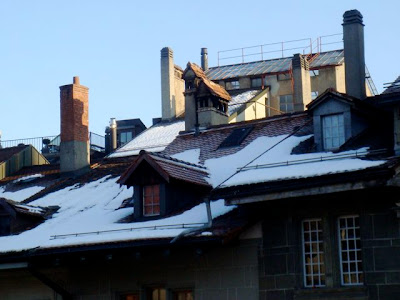
Mykonos has never been a particularly important island historically speaking. Its inhabitants were primarily sailors and fishermen with a few farmers to supplement the fish. During Ancient Greek times the island would supply the Sanctuaries on Delos with food and building supplies. The Romans and the Venetians used it essentially as a warehouse and it was key to fighting the Turks during the Greek War of Independence in 1812 due to its large fleet of ships and its capable sailors.
After World War I Mykonos became a tourist destination due to its proximity to Delos and the growing interest in visiting ancient ruins among the world's travelers. After World War II tourism became its primary industry and it has been a popular resort island every since.
Our first sight upon arriving on the island was this enormous pelican. We discovered his name is Petros and he has been the island's mascot since 1953.

Of course, this is not the original Petros. He died years ago. Not sure which pelican they are on now. But male or female, they are always named "Petros."
As with every port in Greece, and many in Italy as well, right next to the dock is a chapel dedicated to St. Nicholas, the patron saint of sailors.

There are numerous other chapels of varying sizes from small to tiny throughout the island. Apparently it was common during storms at sea for sailors to pray to God for help. As part of their prayer they would often would promise to build a chapel on their island if God would but save them from their watery fate. The Mediterranean and Aegean Seas must be very stormy, because there are a lot of little chapels.
And so we continued on to see what the town had to offer us.
There were some lovely homes...

An interesting district called "Little Venice..."

And the iconic windmills on the hill....

But mostly what the town had to offer was shopping.

Other options for activities on the island are to spend your day at the beach and party most of the night.
Since these are not activities either of us are terribly interested in pursuing, we went back to the ship and took advantage of its emptiness by claiming one of the extremely comfortable, and highly prized, double chaises in the shady and breezy area of the deck where we read our books, sipped margaritas and napped the afternoon away.
As others came back from their trips to the beach, we listened to their stories with amusement.
See, most of the people on the ship were Americans. And, obviously, the Mykonos beaches are European. Most Americans are unaccustomed to the nudity at European beaches.
What made it especially shocking, which was all the more amusing for us, is that Mykonos is also known as the Gay Capital of the Mediterranean.
Yep, nude gay guys hanging out together and participating in "public displays of affection."
How do you think the American tourists reacted to that?
Perhaps the ship should have done more to warn them than simply announcing in the daily schedule of events that the beaches on Mykonos are lovely, but tend to be full of young, fun-loving people and are quite liberal.
But that would have ruined our fun. And perhaps the fun of the ship's crew as well!
And what might also be fun is to see how many extra hits I get because of certain words used in this post. Any wagers as to the increase per day?
 And here's the view from below:
And here's the view from below: Global Baby is mesmerized by it.
Global Baby is mesmerized by it.








































